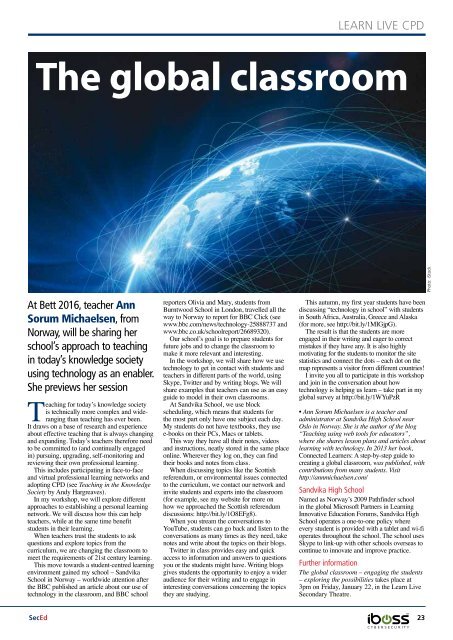Bett 2016
BettShow2016
BettShow2016
Create successful ePaper yourself
Turn your PDF publications into a flip-book with our unique Google optimized e-Paper software.
LEARN LIVE CPD<br />
The global classroom<br />
Photo: iStock<br />
At <strong>Bett</strong> <strong>2016</strong>, teacher Ann<br />
Sorum Michaelsen, from<br />
Norway, will be sharing her<br />
school’s approach to teaching<br />
in today’s knowledge society<br />
using technology as an enabler.<br />
She previews her session<br />
Teaching for today’s knowledge society<br />
is technically more complex and wideranging<br />
than teaching has ever been.<br />
It draws on a base of research and experience<br />
about effective teaching that is always changing<br />
and expanding. Today’s teachers therefore need<br />
to be committed to (and continually engaged<br />
in) pursuing, upgrading, self-monitoring and<br />
reviewing their own professional learning.<br />
This includes participating in face-to-face<br />
and virtual professional learning networks and<br />
adopting CPD (see Teaching in the Knowledge<br />
Society by Andy Hargreaves).<br />
In my workshop, we will explore different<br />
approaches to establishing a personal learning<br />
network. We will discuss how this can help<br />
teachers, while at the same time benefit<br />
students in their learning.<br />
When teachers trust the students to ask<br />
questions and explore topics from the<br />
curriculum, we are changing the classroom to<br />
meet the requirements of 21st century learning.<br />
This move towards a student-centred learning<br />
environment gained my school – Sandvika<br />
School in Norway – worldwide attention after<br />
the BBC published an article about our use of<br />
technology in the classroom, and BBC school<br />
reporters Olivia and Mary, students from<br />
Burntwood School in London, travelled all the<br />
way to Norway to report for BBC Click (see<br />
www.bbc.com/news/technology-25888737 and<br />
www.bbc.co.uk/schoolreport/26689320).<br />
Our school’s goal is to prepare students for<br />
future jobs and to change the classroom to<br />
make it more relevant and interesting.<br />
In the workshop, we will share how we use<br />
technology to get in contact with students and<br />
teachers in different parts of the world, using<br />
Skype, Twitter and by writing blogs. We will<br />
share examples that teachers can use as an easy<br />
guide to model in their own classrooms.<br />
At Sandvika School, we use block<br />
scheduling, which means that students for<br />
the most part only have one subject each day.<br />
My students do not have textbooks, they use<br />
e-books on their PCs, Macs or tablets.<br />
This way they have all their notes, videos<br />
and instructions, neatly stored in the same place<br />
online. Wherever they log on, they can find<br />
their books and notes from class.<br />
When discussing topics like the Scottish<br />
referendum, or environmental issues connected<br />
to the curriculum, we contact our network and<br />
invite students and experts into the classroom<br />
(for example, see my website for more on<br />
how we approached the Scottish referendum<br />
discussions: http://bit.ly/1O8EFg8).<br />
When you stream the conversations to<br />
YouTube, students can go back and listen to the<br />
conversations as many times as they need, take<br />
notes and write about the topics on their blogs.<br />
Twitter in class provides easy and quick<br />
access to information and answers to questions<br />
you or the students might have. Writing blogs<br />
gives students the opportunity to enjoy a wider<br />
audience for their writing and to engage in<br />
interesting conversations concerning the topics<br />
they are studying.<br />
This autumn, my first year students have been<br />
discussing “technology in school” with students<br />
in South Africa, Australia, Greece and Alaska<br />
(for more, see http://bit.ly/1MIGjpG).<br />
The result is that the students are more<br />
engaged in their writing and eager to correct<br />
mistakes if they have any. It is also highly<br />
motivating for the students to monitor the site<br />
statistics and connect the dots – each dot on the<br />
map represents a visitor from different countries!<br />
I invite you all to participate in this workshop<br />
and join in the conversation about how<br />
technology is helping us learn – take part in my<br />
global survey at http://bit.ly/1WYuPzR<br />
• Ann Sorum Michaelsen is a teacher and<br />
administrator at Sandvika High School near<br />
Oslo in Norway. She is the author of the blog<br />
“Teaching using web tools for educators”,<br />
where she shares lesson plans and articles about<br />
learning with technology. In 2013 her book,<br />
Connected Learners: A step-by-step guide to<br />
creating a global classroom, was published, with<br />
contributions from many students. Visit<br />
http://annmichaelsen.com/<br />
Sandvika High School<br />
Named as Norway’s 2009 Pathfinder school<br />
in the global Microsoft Partners in Learning<br />
Innovative Education Forums, Sandvika High<br />
School operates a one-to-one policy where<br />
every student is provided with a tablet and wi-fi<br />
operates throughout the school. The school uses<br />
Skype to link-up with other schools overseas to<br />
continue to innovate and improve practice.<br />
Further information<br />
The global classroom – engaging the students<br />
– exploring the possibilities takes place at<br />
3pm on Friday, January 22, in the Learn Live<br />
Secondary Theatre.<br />
SecEd 23


